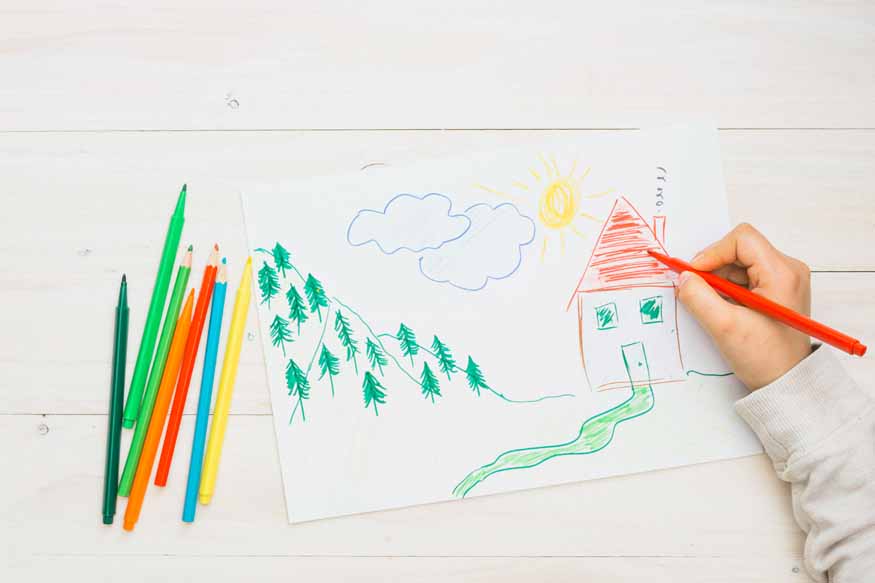Drawing is an excellent activity for children that can provide numerous developmental benefits. Drawing is a fun and engaging way for kids to explore their world, from improving fine motor skills to encouraging creativity and imagination.
Teaching your child to draw, on the other hand, can be a daunting task, especially if you don’t know where to start. This blog will review the various stages of drawing development, the benefits of drawing for kids, and some tips and techniques for teaching your child to draw. Whether your child is an aspiring artist or just getting started, In this blog post, we’ll go over some helpful tips and techniques for teaching your kids to draw, covering everything from the fundamental skills they’ll need to get started to the various materials and tools that can boost their creativity and enjoyment.
Drawing is a relaxing and enjoyable kind of art. Furthermore, acquiring the art of drawing can improve productivity in other mediums. Having precision in drawing is the foundation of a future artist. Drawing can help people express themselves better. It is a great form of art for several people who cannot always express themselves through words and prefer to not mix with people. As a result, sketching can be an effective means of communication for people.
People’s drawings might provide insight into their thoughts and feelings. Their feelings can be understood by evaluating the drawing’s colour scheme, design, style, and theme. The ability to express oneself through sketching has the advantage of increasing one’s emotional intelligence. Drawing improves people’s motor skills. When youngsters become accustomed to drawing, their motor abilities might develop from an early age. Drawing also helps people improve their hand and eye coordination, as well as fine-tune their finger muscles.
Drawing allows people to unleash their creativity. This is because when people draw, they tend to summon their imagination from the depths of their being and put it on paper. People’s imaginations would grow more active as they created things on paper inspired by their surroundings.
Stages of Reading
Children’s drawing abilities progress through various stages of reading as they grow. Children’s drawings start as simple scribbles, but as they get older, they become more detailed and recognizable. As children progress through the stages of drawing, they begin to use more complex shapes and lines to create more detailed and realistic images. The four major stages of drawing development are as follows.
- Scribbling Stage:
- Pre-Schematic Stage:
- Realistic Stage:
This is the first stage of drawing development, usually between the ages of two and four. Children at this stage draw scribble with simple, random lines and shapes without tangible form or structure.
Typically, this stage occurs between ages 4 and 7. Children at this age begin to draw basic shapes and lines representing objects. For example, they could draw a circle with two lines extending from it. Schematic Stage: This stage occurs between the ages of 7 and 9. Children at this stage develop more advanced drawing skills and begin to draw objects with greater detail and structure. To represent more complex objects, they may also use symbols and labels.
This is the final stage of drawing development, usually between 9 and 10. Children at this stage have advanced drawing skills and can create realistic drawings with accurate proportions and details. Understanding the stages of drawing development can help parents and educators better support and encourage children’s artistic growth. While the stages of drawing are a general guide, every child develops their unique style and progresses at their own pace.
Stages of Drawing Development

After discussing the stages of drawing development and the benefits of drawing for children, here are some tips and techniques for teaching your child to draw:
- Begin with Basic Shapes:
- Follow the Step-by-Step Instructions:
- Encourage Exploration:
- Use Visual Aids:
- Provide The Right Tools:
- Make It Fun:
- Practice Makes Perfect:
Teaching your children basic shapes is one of the simplest ways to get them started withdrawing. This will help them hone their skills in creating simple objects and characters while laying the groundwork for more complex drawings. Begin with basic shapes such as circles, squares, and triangles, and encourage your child to experiment with various combinations and sizes.
Your child will understand various objects’ basic structures and proportions by breaking down the drawing process into simple steps. Show them how to draw each step, from simple shapes to more complex lines and details, by providing step-by-step instructions. This will also help them improve their problem-solving abilities as they figure out how to draw something from their imagination.
Encouraging your child to use their imagination and creativity is important in teaching them to draw. Allow them to experiment with different colours, shapes, and styles, and allow them to make mistakes. Encourage them to try new things and to create their drawings with their ideas and imagination.
It can sometimes be difficult for children to imagine what they want to draw. Using visual aids to spark their imagination and inspire them to create their drawings can help them overcome this challenge. Books, magazines, pictures, and other images demonstrating various drawing styles and techniques can be used as visual aids. You can help children develop their artistic skills and confidence by exposing them to various visual aids.
Providing the right tools for your child to enjoy drawing is critical. Provide them with high-quality materials such as paper, pencils, markers, and crayons. High-quality tools can help them improve their skills while making the process more enjoyable.
Drawing is a fantastic way to express yourself and let your creativity run wild. However, drawing can be frustrating or stressful if they feel pressured to produce perfect results or compare themselves to others. That is why it is critical to encourage your child to enjoy the creative process rather than focusing solely on the result. Create a positive and encouraging environment where your child can experiment with various materials, colours, and techniques without fear of making mistakes. Praise their efforts and creativity rather than their results. Inquire about their drawings and listen to their stories.
Drawing, like any other skill, requires practice to develop. Encourage your child to practice regularly and to persevere even when they make mistakes. Inform them that making mistakes is a natural part of the learning process and that they can learn from them.
Drawing Milestones
- Developmental Stages of Drawing:
- Starting with Basics:
- Step-by-Step Guidance:
- Encouraging Creativity:
- Using Visual Aids:
- Providing Quality Tools:
- Fostering a Positive Environment:
- Regular Practice:
Children’s drawing skills evolve through various stages, from simple scribbling to creating detailed, realistic images. Understanding these stages helps in nurturing their artistic growth and it is one of the primary drawing milestones.
Introduce children to basic shapes to lay the foundation for more complex drawings. This approach helps in building their drawing skills gradually.
Break down the drawing process into manageable steps. This method teaches children about structure and proportion, enhancing their problem-solving skills.
Promote imagination and experimentation in drawing. Allow children to explore different styles, colours, and shapes, emphasizing the importance of enjoying the process over achieving perfection.
Incorporate books, pictures, and other images to inspire and guide children in their drawing endeavours.
Equip children with high-quality drawing materials. This not only makes the process more enjoyable but also aids in skill development.
Create a supportive atmosphere where children can express themselves freely without fear of criticism. Focus on praising their effort and creativity.
Encourage consistent practice to refine drawing skills. Emphasize that making mistakes is a natural part of learning and improvement.
By reading this blog, you would have understood the various benefits of drawing for kids. Teaching your children to draw can be a rewarding and enjoyable experience that will aid in developing their creativity, imagination, and problem-solving abilities. You can help your child develop their artistic skills and enjoy creating art by starting with basic shapes, using step-by-step instructions, encouraging exploration, providing the right materials, giving positive feedback, and making it fun. Preschoolers like EuroKids believe in providing a safe and nurturing environment in which your children can freely express themselves and develop their artistic style.
The curriculum is inspired by our ‘Child First’ philosophy -Eunoia, and our special curriculum keeps a child’s innocent and beautiful mind at the heart of everything we do. Visit the nearest EuroKids centre to know more!
For informative and accurate articles on all things related to your new born-toddler’s development, growth, health and nutrition, follow EuroKids Blogs and do check out our nationally recognized preschools – EuroKids for the first step in your kid’s educational journey!
















